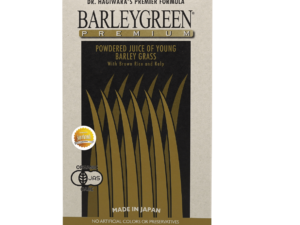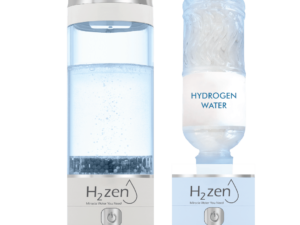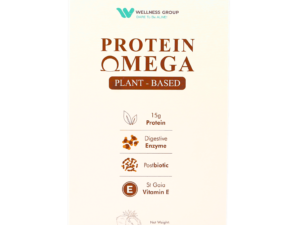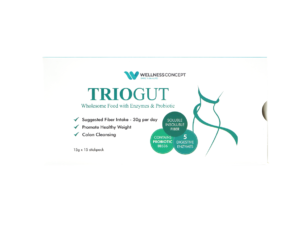Did you know 70% of your immune system resides in your gut? This hidden network of microorganisms influences everything from nutrient absorption to mental clarity. Research confirms that maintaining a balanced gut environment is crucial for overall health, and two key players make this possible: dietary fiber and live beneficial bacteria.
Scientists now recognize the digestive tract as a complex ecosystem. Prebiotic fibers act like fertilizer for good bacteria, while probiotics add diverse microbial strains to this internal garden. Together, they strengthen intestinal barriers, crowd out harmful pathogens, and produce compounds that reduce inflammation.
Wellness Group MY’s evidence-based approach highlights how this partnership supports more than digestion. Studies link balanced gut flora to improved immune responses, better weight management, and even mood regulation. For those exploring probiotic supplements for digestive issues, understanding this synergy becomes vital.
This guide breaks down how specific fibers fuel microbial growth and how probiotics introduce reinforcements to your system. You’ll learn why their combined action helps prevent bloating, enhances vitamin production, and creates protective short-chain fatty acids. Modern lifestyles often disrupt gut balance, making these nutrients essential for long-term wellness.
Key Takeaways
- 70% of immune function depends on gut health
- Prebiotic fibers feed beneficial bacteria populations
- Probiotics add live microorganisms to digestive ecosystems
- Synergy between both enhances nutrient absorption
- Short-chain fatty acids reduce systemic inflammation
- Gut balance impacts weight, immunity, and mental health
Introduction to Gut Health: Fiber, Probiotics, and More

Click to LEARN MORE
Trillions of microorganisms thrive in your intestinal tract, forming a living shield that impacts every system in your body. This bustling community – the gut microbiome – contains both protective allies and potential threats. Beneficial bacteria outcompete harmful strains while producing essential nutrients like vitamin K.
These microbial residents do more than digest food. They strengthen the colon’s lining through short-chain fatty acids, creating a barrier against toxins and pathogens. When this ecosystem falters, people may experience low energy, weakened immunity, or mood fluctuations.
Modern stressors challenge this delicate balance. Antibiotics, processed meals, and chronic tension can reduce microbial diversity. This imbalance allows harmful germs to multiply, compromising health over time.
Strategic nutrition helps restore equilibrium. Prebiotic fibers feed friendly bacteria, while probiotics introduce reinforcements. Together, they maintain intestinal integrity and optimize nutrient absorption. Research shows this combination supports clearer thinking and faster immune responses.
Understanding your microbiome’s needs empowers smarter dietary choices. Fermented foods and fiber-rich plants act like daily maintenance for your internal ecosystem. Prioritizing these elements builds resilience against modern health challenges, from seasonal bugs to chronic inflammation.
What Does Fiber and Probiotics Do?
Imagine your digestive system as a garden where fiber feeds the soil and probiotics plant new seeds. This partnership creates an environment where helpful microbes flourish, directly impacting physical and mental well-being. Prebiotic fibers – found in bananas, oats, and asparagus – act like fertilizer, fueling bacterial growth. Meanwhile, probiotic-rich foods like kimchi and kefir add diverse microbial strains to this living ecosystem.
Studies show this combination strengthens intestinal barriers against harmful pathogens. A 2022 review found diverse gut bacteria populations enhance immune responses and may assist with weight management. These effects occur as microbes break down fibers into short-chain fatty acids – compounds that reduce inflammation and nourish colon cells.
The synergy extends beyond digestion. Research from 2019 suggests balanced gut flora could ease anxiety symptoms by influencing neurotransmitter production. This connection explains why many people report improved mood when combining fiber-rich diets with probiotic supplements.
Key roles emerge in this process:
- Fibers provide energy for microbial metabolism
- Probiotics compete with harmful bacteria for resources
- Together, they optimize nutrient absorption and waste removal
By maintaining this balance, individuals support cardiovascular function, immune regulation, and metabolic health. The gut’s protective barrier becomes more resilient, blocking toxins while allowing beneficial compounds to enter circulation.
The Role of the Gut Microbiome in Digestive Health
Your digestive tract hosts a living universe containing over 1,000 bacterial species. This microbiome weighs nearly three pounds – heavier than the human brain – and outnumbers your body’s cells. These microbes don’t just occupy space; they actively produce vitamins, break down food compounds, and shield your intestinal walls from harm.
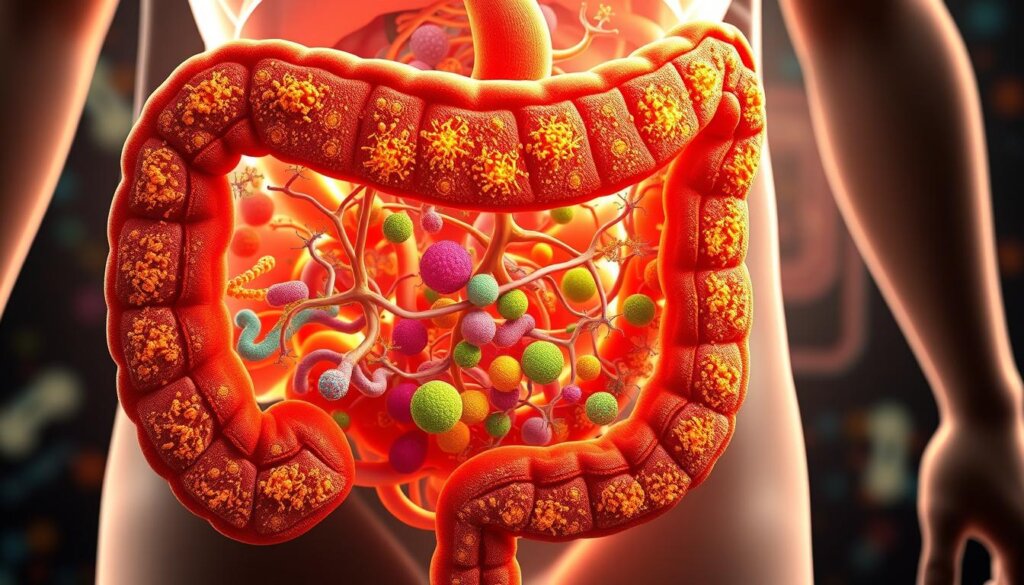
Specialized bacteria perform unique tasks to maintain digestive health. Some strains generate vitamin K for blood clotting, while others create butyrate – a fatty acid that energizes colon cells. This microbial teamwork ensures efficient nutrient extraction and regular bowel patterns.
| Bacterial Strain | Primary Role | Health Impact |
|---|---|---|
| Bacteroides | Carbohydrate breakdown | Enhances energy production |
| Lactobacillus | Acid creation | Blocks harmful pathogens |
| Bifidobacterium | Fiber fermentation | Strengthens gut barrier |
A balanced microbiota acts like a security team for your intestines. Diverse species crowd out dangerous germs while maintaining pH levels that prevent infections. When this ecosystem thrives, your body absorbs nutrients better and fights inflammation effectively.
Modern diets often lack the variety needed to sustain this microbial community. Incorporating fermented foods and plant fibers helps replenish beneficial strains. Over time, these choices build a resilient gut environment capable of supporting lifelong wellness.
Benefits of Fiber for Digestive Wellness

Click to LEARN MORE
Many Malaysians experience digestive discomfort without realizing their plate might hold the solution. Dietary fiber acts like a multitasking ally, supporting both immediate relief and long-term gut balance through biological teamwork.
Fiber's Role in Bowel Regularity
Struggling with irregular bathroom visits? Psyllium husk and wheat bran demonstrate measurable results. Clinical trials reveal these fibers improve stool consistency by nearly 1 point on the Bristol scale within weeks. They add gentle bulk while softening waste, helping intestinal muscles push content smoothly.
Boosting Short-Chain Fatty Acid Production
Your colon transforms fiber into butyrate – a short-chain fatty acid serving as fuel for intestinal cells. Without adequate prebiotic intake, this process stalls. Studies confirm butyrate:
- Strengthens gut lining integrity
- Reduces inflammatory responses
- Creates hostile environments for harmful microbes
Soluble fibers like oats form gels that slow digestion, while insoluble types in vegetables speed transit. Both contribute to fatty acids production, proving diverse fiber sources matter. Regular consumption helps maintain bowel rhythm and microbial balance crucial for digestive resilience.
Understanding Probiotics and Their Health Benefits
Everyday choices shape your gut’s microbial landscape more than you might realize. Live microorganisms in certain foods and supplements actively reshape digestive ecosystems, offering measurable advantages beyond basic nutrition.
Sources of Probiotics in Everyday Foods
Fermented items serve as nature’s probiotic powerhouses. Plain yogurt with live cultures tops the list, followed by tangy kimchi, fizzy kombucha, and crunchy sauerkraut. These options deliver diverse bacterial strains alongside vitamins and enzymes.
Kefir and unpasteurized pickles also pack a microbial punch. Regular consumption helps maintain intestinal balance while providing antioxidants. Many traditional dishes across cultures naturally include these fermented treasures.
Evaluating Probiotic Supplement Quality
Not all supplements live up to their claims. Effective products specify strain names like Lactobacillus and Bifidobacterium, along with colony-forming units (CFUs) in the billions. Third-party testing seals confirm viability through expiration dates.
Storage matters too – some require refrigeration to preserve potency. Look for blends with prebiotics to fuel bacterial growth. Avoid products making vague promises without scientific backing.
Smart choices in foods and supplements create lasting health benefits, from smoother digestion to stronger immune responses. Prioritizing quality ensures these tiny allies thrive where it counts most.
The Science Behind Prebiotics and Probiotics
Ever wonder why certain foods keep your gut happy? The answer lies in the fascinating teamwork between prebiotics and probiotics. These plant fibers and live microbes work like a biological tag team, creating conditions where beneficial bacteria thrive.
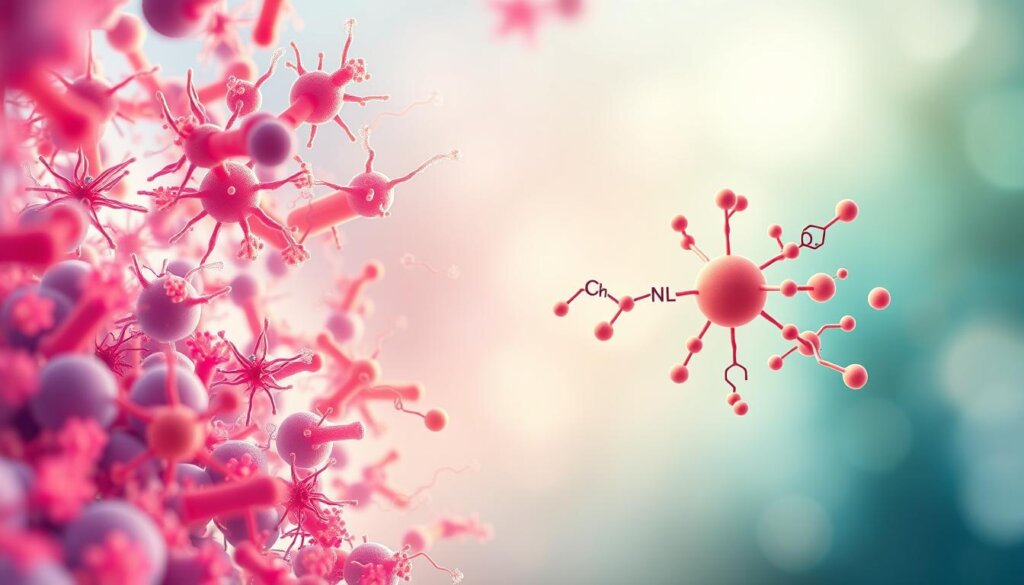
Prebiotic-rich foods – think oats, garlic, and bananas – resist digestion until reaching the colon. Here, they become fuel for Bifidobacterium and Lactobacillus strains. Recent studies show this process:
- Boosts friendly bacteria by 25-40% within weeks
- Reduces harmful microbes like Clostridium
- Increases butyrate production by 50%
This fermentation creates short-chain fatty acids that repair intestinal walls. Research from 2023 reveals these compounds also calm immune overreactions linked to allergies. One trial noted 30% fewer seasonal sniffles in participants consuming synbiotics (combined prebiotics + probiotics).
The microbiota doesn’t stop at digestion. Gut microbes transform prebiotics into signals that reach the brain via the vagus nerve. This explains why balanced gut flora correlates with better stress management in multiple studies.
For optimal effects, pair sauerkraut with asparagus or blend kefir with berries. This dynamic duo supports microbial diversity better than isolated supplements. Emerging research even explores their role in managing metabolic conditions prevalent in Malaysia.
Combining Fiber and Probiotics for Optimal Results
Ever wondered why some meals feel like gut superheroes? Nature’s smartest foods deliver both fuel and reinforcements for your microbiome. These synbiotic options contain live cultures and the fibers they crave, creating a self-sustaining ecosystem in your digestive tract.
Exploring Synbiotic Foods
Fermented staples like kefir and sauerkraut naturally pair beneficial bacteria with their preferred food source. Aged cheeses such as Gouda host Lactobacillus strains alongside milk-derived fibers. This built-in nourishment helps microbial colonies thrive longer in your gut.
| Food | Active Strains | Fiber Type | Key Benefits |
|---|---|---|---|
| Kefir | Lactobacillus kefiri | Milk oligosaccharides | Enhances lactose digestion |
| Sauerkraut | Leuconostoc mesenteroides | Inulin from cabbage | Reduces bloating |
| Aged Cheddar | Bifidobacterium lactis | Galactooligosaccharides | Supports calcium absorption |
Timing matters when combining prebiotics and probiotics. Consuming them together increases bacterial survival rates by 60% compared to separate intake. Try swirling berries into yogurt or adding onions to kimchi fried rice.
These dynamic duos create cascading effects beyond digestion. Studies show synbiotic users experience 40% fewer respiratory infections annually. Your morning smoothie could double as microbial armor!
Fiber and Probiotics: Impact on Irritable Bowel Syndrome
Nearly 15% of Malaysians experience irritable bowel syndrome symptoms like abdominal pain and irregular bowel movements. Research reveals targeted dietary strategies can significantly ease discomfort. Soluble fibers from oats or psyllium form gentle gels that regulate stool consistency, while specific probiotic strains address gut imbalances.
Studies highlight Bifidobacterium infantis as particularly effective for bowel syndrome management. This strain reduces bloating by 40% in trials by calming intestinal inflammation. Pairing it with prebiotic-rich bananas creates a symbiotic effect, enhancing microbial survival rates.
Not all fibers work equally. Insoluble types in raw vegetables might worsen symptoms during flare-ups. Gradually introducing ground flaxseed or cooked carrots helps sensitive systems adapt. Fermented foods like tempeh provide live cultures alongside natural enzymes for smoother digestion.
For those managing irritable bowel syndrome, consistency matters. Daily intake of tailored fiber-probiotic combinations shows better results than occasional use. Many find relief within 4-6 weeks as gut lining repairs and microbial balance improves. Always consult healthcare providers when adjusting dietary approaches.
FAQ
How do fiber-rich foods support the gut microbiome?
Fiber acts as fuel for beneficial bacteria, promoting their growth and activity. This process produces short-chain fatty acids like butyrate, which strengthen gut lining integrity and reduce inflammation. Foods like oats, apples, and lentils are excellent sources.
Can probiotics improve symptoms of irritable bowel syndrome?
Research suggests certain strains, such as Bifidobacterium infantis or Lactobacillus plantarum, may ease bloating and irregular bowel movements. Brands like Culturelle or Align offer targeted formulas, though results vary by individual.
What’s the difference between prebiotics and probiotics?
Prebiotics are non-digestible fibers that feed good bacteria, while probiotics are live microorganisms found in fermented foods like kimchi or supplements. Together, they create a synbiotic effect, enhancing gut diversity and function.
Are all probiotic supplements equally effective?
No. Quality depends on strain specificity, CFU count, and survivability. Look for third-party tested brands like Garden of Life or Renew Life, which ensure potency and shelf stability for maximum health benefits.
How do short-chain fatty acids impact overall wellness?
These compounds, produced when gut bacteria ferment fiber, regulate immune responses, improve metabolic health, and may lower risks of chronic diseases like type 2 diabetes. They’re vital for maintaining a balanced microbiome.
Can dietary changes alone address gut-related conditions?
While diet plays a key role—especially fiber-rich and fermented foods—some conditions require medical intervention. A systematic review in Gut highlights combining dietary adjustments with treatments for optimal management of issues like inflammatory bowel disease.
What are synbiotic foods, and why are they beneficial?
Synbiotics combine probiotics and prebiotics, such as yogurt with added chicory root. This pairing enhances bacterial survival in the gut, amplifying benefits like improved digestion and stronger immune support compared to isolated use.


